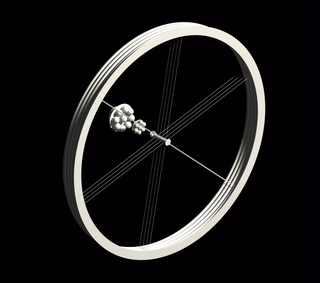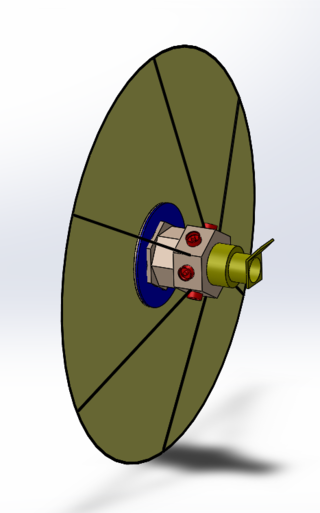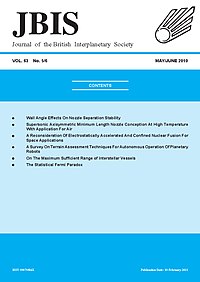
Interstellar travel is the hypothetical travel of spacecraft from one star system, solitary star, or planetary system to another. Interstellar travel is expected to prove much more difficult than interplanetary spaceflight due to the vast difference in the scale of the involved distances. Whereas the distance between any two planets in the Solar System is less than 30 astronomical units (AU), stars are typically separated by hundreds of thousands of AU, causing these distances to typically be expressed instead in light-years. Because of the vastness of these distances, non-generational interstellar travel based on known physics would need to occur at a high percentage of the speed of light; even so, travel times would be long, at least decades and perhaps millennia or longer.

Solar sails are a method of spacecraft propulsion using radiation pressure exerted by sunlight on large surfaces. A number of spaceflight missions to test solar propulsion and navigation have been proposed since the 1980s. The first spacecraft to make use of the technology was IKAROS, launched in 2010.

The Bussard ramjet is a theoretical method of spacecraft propulsion for interstellar travel. A fast moving spacecraft scoops up hydrogen from the interstellar medium using an enormous funnel-shaped magnetic field ; the hydrogen is compressed until thermonuclear fusion occurs, which provides thrust to counter the drag created by the funnel and energy to power the magnetic field. The Bussard ramjet can thus be seen as a ramjet variant of a fusion rocket.

Nuclear pulse propulsion or external pulsed plasma propulsion is a hypothetical method of spacecraft propulsion that uses nuclear explosions for thrust. It originated as Project Orion with support from DARPA, after a suggestion by Stanislaw Ulam in 1947. Newer designs using inertial confinement fusion have been the baseline for most later designs, including Project Daedalus and Project Longshot.

Spaceflight is an application of astronautics to fly spacecraft into or through outer space, either with or without humans on board. Most spaceflight is uncrewed and conducted mainly with spacecraft such as satellites in orbit around Earth, but also includes space probes for flights beyond Earth orbit. Such spaceflight operates either by telerobotic or autonomous control. The more complex human spaceflight has been pursued soon after the first orbital satellites and has reached the Moon and permanent human presence in space around Earth, particularly with the use of space stations. Human spaceflight programs include the Soyuz, Shenzhou, the past Apollo Moon landing and the Space Shuttle programs, with currently the International Space Station as the main destination of human spaceflight missions while China's Tiangong Space Station is under construction.

A generation ship, or generation starship, is a hypothetical type of interstellar ark starship that travels at sub-light speed. Since such a ship might require hundreds to thousands of years to reach nearby stars, the original occupants of a generation ship would grow old and die, leaving their descendants to continue traveling.
An interstellar ark is a conceptual starship designed for interstellar travel. Interstellar arks may be the most economically feasible method of traveling such distances. The ark has also been proposed as a potential habitat to preserve civilization and knowledge in the event of a global catastrophe.

Project Daedalus was a study conducted between 1973 and 1978 by the British Interplanetary Society to design a plausible uncrewed interstellar probe. Intended mainly as a scientific probe, the design criteria specified that the spacecraft had to use existing or near-future technology and had to be able to reach its destination within a human lifetime. Alan Bond led a team of scientists and engineers who proposed using a fusion rocket to reach Barnard's Star 5.9 light years away. The trip was estimated to take 50 years, but the design was required to be flexible enough that it could be sent to any other target star.

The British Interplanetary Society (BIS), founded in Liverpool in 1933 by Philip E. Cleator, is the oldest existing space advocacy organisation in the world. Its aim is exclusively to support and promote astronautics and space exploration.
Alan Bond is a British mechanical and aerospace engineer, who served as Managing Director of Reaction Engines Ltd and associated with Project Daedalus, Blue Streak missile, HOTOL, Reaction Engines Skylon and the Reaction Engines A2 hypersonic passenger aircraft.

An interstellar probe is a space probe that has left—or is expected to leave—the Solar System and enter interstellar space, which is typically defined as the region beyond the heliopause. It also refers to probes capable of reaching other star systems.

Reaction Engines Limited is a British aerospace manufacturer based in Oxfordshire, England.

Deep space exploration is the branch of astronomy, astronautics and space technology that is involved with exploring the distant regions of outer space. However, there is little consensus on the meaning of "distant" regions. In some contexts, it is used to refer to interstellar space. The International Telecommunication Union defines "deep space" to start at a distance of 2 million km from the Earth's surface. NASA's Deep Space Network has variously used criteria of 16,000 to 32,000 km from Earth. Physical exploration of space is conducted both by human spaceflights and by robotic spacecraft.
In astronautics, a black hole starship is the theoretical concept of a starship capable of interstellar travel using a black hole as an energy source for spacecraft propulsion. The concept was first discussed in science fiction, notably in the book Imperial Earth by Arthur C. Clarke, and in the work of Charles Sheffield, in which energy extracted from a Kerr–Newman black hole is described as powering the rocket engines in the story "Killing Vector" (1978).
Eugene F. Lally was American aerospace engineer. He worked in the early 1960s on U.S. interplanetary space programs. Beside his space programs he was also an inventor and developed non-space products with his own company Dynamic Development Co. which he founded in the early 1960s. He later became an active amateur photographer and lubrication product entrepreneur. Lally contributed articles for popular space, astrobiology, photography, travel, and archaeology magazines. He was also a speaker at local space exploration and extraterrestrial intelligence (UFO) society meetings where he gave first-hand accounts of the early U.S. space program, commentaries on current U.S. space exploration activities and the search for extraterrestrial intelligence.
Project Icarus is a theoretical engineering design study aimed at designing a credible, mainly nuclear fusion-based, unmanned interstellar space probe. Project Icarus was an initiative of members of the British Interplanetary Society (BIS) and the Tau Zero Foundation (TZF) started in 2009. The project was under the stewardship of Icarus Interstellar until 2019. It remains a BIS project.

The Enzmann starship is a concept for a crewed interstellar spacecraft proposed in 1964 by Dr. Robert Enzmann. A three million ton ball of frozen deuterium would fuel nuclear fusion rocket engines contained in a cylindrical section behind that ball with the crew quarters. The craft would be about 2,000 feet (600 m) long overall.

The Apollo spacecraft feasibility study was conducted by NASA from July 1960 through May 1961 to investigate preliminary designs for a post-Project Mercury multi-crewed spacecraft to be used for possible space station, circum-lunar, lunar orbital, or crewed lunar landing missions. Six-month, $250,000 study contracts were awarded to General Dynamics/Convair, General Electric, and the Glenn L. Martin Company. Meanwhile, NASA conducted its own inhouse design study led by Maxime Faget, intended as a gauge of the competitors' entries. The three companies spent varying amounts of their own money in excess of the $250,000 to produce designs which included a re-entry module separate from the mission module cabin, and a propulsion and equipment module.

Project Dragonfly is the first conceptual design study that assesses the feasibility of a laser-propelled interstellar probe, conducted by the Initiative for Interstellar Studies. Contrary to past unmanned interstellar mission studies such as Project Daedalus and Project Icarus, the focus is particularly on a small spacecraft. The project was founded in 2013 by the Initiative for Interstellar Studies (i4is).

Leslie Robert Shepherd was a Welsh nuclear physicist. He was involved in the design and operation of the experimental Dragon reactor, which used helium as a coolant. He was also an advocate of space exploration, serving as the president of the British Interplanetary Society and the International Astronautical Federation.















